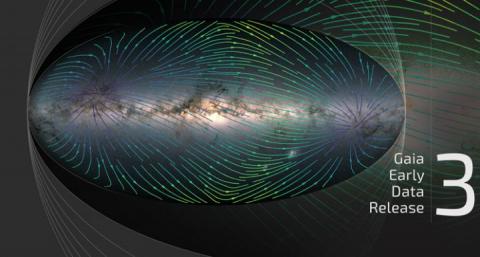
Submitted by Administrator on Thu, 03/12/2020 - 21:08
On December 3, 2020, ESA presented the first part of the 3rd Gaia data release (Gaia Early Data Release 3, Gaia EDR3).
This includes the astrometry and broad-band photometry that will also be part of the complete 3rd Gaia data release, scheduled for the first half of 2022, and which will contain in addition a wide range of derived products such as variability investigations and astrophysical parameters. Gaia EDR3 delivers data for just over 1.8 billion sources. Following the success of the previous Gaia data release, this release is expected to make an even bigger impact on an even wider range of topics in astrophysics, as reflected in the already very high number of papers using, and depending on, the Gaia data, and similarly high number of citations to many of these papers.
The astrometric data in Gaia EDR3 are characterised by parallaxes with precisions improved by - on average - a factor of 1.5, and proper motions improved by on average a factor of 2 (with respect to the 2nd release that took place 2.5 years ago). Systematic errors in the parallaxes have been investigated in great detail, and tend to be at a level of 10 to 20 micro arcseconds, with dependencies on brightness and position on the sky. A provisional algorithm is provided that significantly reduces systematics in the parallax zeropoint. The improvements in the proper motion accuracy with respect to the 2nd Gaia data release stems from the longer time span covered, as proper motion accuracies improve with the length of the time span to the power 1.5. For the next, 4th Gaia data release, which is to cover 66 months of data, a further improvement in proper motion accuracies by a factor 2.7 can be expected. The impact of these improvements in the astrometric data has been demonstrated in papers accompanying Gaia EDR3, in particular on the LMC/SMC, where multiple populations can now be distinguished in proper motion patterns linked to different age stellar populations, and in the census of the 100 pc sphere around the Sun, where the full 6D phase space can be studied for over 330,000 stars. Radial velocities for many of the stars are another Gaia data product. The potential of the proper motions shows in the picture above: significant systematics in proper motions, reflecting the solar motion, are now well detected, even at 1 kpc distance.
A crucially important element of the Gaia data releases is the photometry, prepared and delivered by the Institute of Astronomy, Cambridge, as part of the UK participation in the Gaia data processing. It covers broad band photometry in a “white”, “red” and “blue” channel, and low-resolution dispersion spectra for the red and blue channels. The Gaia photometric data is unique in many ways: it represents a high resolution (currently about 0.5 arcsec, but 0.2 arcsec is possible) homogeneous all-sky survey, something that is not possible to achieve with ground-based photometry, and it is doing so at a close to mmag level accuracy. The combination of this high-accuracy photometry with the astrometry, providing accurate distance moduli, for 100s of millions of sources opens the door to a wide range of detailed studies, ranging from galactic dynamics and the history of our Galaxy to detailed studies of star clusters, both open and globular, and the detailed information this can provide, for example, on studies of stellar evolution.
One particular application of the Gaia EDR3 data is the measurement of the acceleration of the Solar System, the change with time of the velocity vector of the Solar System in space. The velocity of the Solar System in space is relatively large with respect to the speed of light, causing the positions of distant objects as observed to be significantly affected, up to 158 arcsec, by aberration. The velocity vector of the Solar System changes with time, primarily due to the gravitational pull from the Galaxy. As a result, the aberration applicable to each source changes, where the changes depend on the position on the sky. This change is now possible to measure, as it reflects in a very specific and systematic apparent proper motion pattern for objects such as QSOs, for which no actual physical proper motion should be present. The amplitude of this effect is at a level of a few micro-arcsec per year, and has been measured to be equivalent to an acceleration of about 7 km/s/Myr (2.32 x 10-10 ms-2).
The new data release is the result of the analysis of the first 34 months of data collected by the satellite and analyzed by the Gaia Data Processing and Analysis Consortium, covering the activities of around 400 scientist and 6 data processing centres, spread over Europe, and involved in the Gaia data processing. The UK contributes through the Institute of Astronomy (IoA) in Cambridge, the Institute for Astronomy (IfA) in Edinburgh, MSSL (UCL) and the University of Leicester. The UK contributions are supported by grants from the UK Space Agency and the STFC.
Contacts:
Gerry Gilmore - UK Gaia PI
Nicholas Walton - UK Gaia co-I and ESA Gaia Science Team Member
Floor van Leeuwen - UK Gaia Project Manager
Dafydd Evans - Gaia DPAC Photometry Lead
Francesca De Angeli - Gaia DPAC Cambridge Data Processing Centre Lead
Links (providing further links to papers accompanying Gaia EDR3):
ESA: https://www.cosmos.esa.int/web/gaia/earlydr3
UK Gaia web pages: https://www.gaia.ac.uk/data/gaia-early-data-release-3


